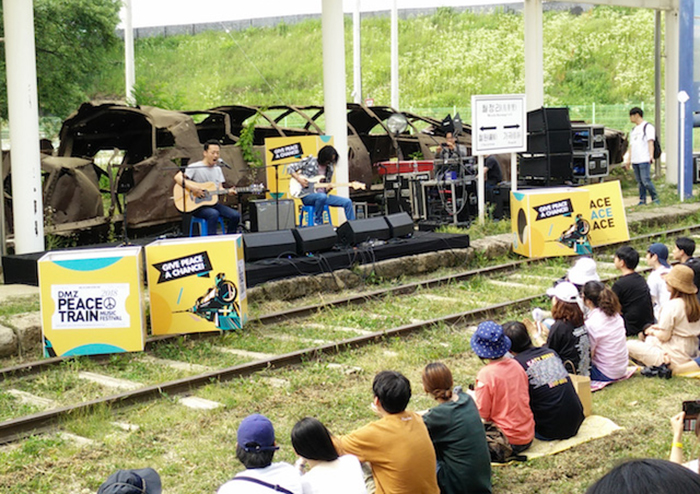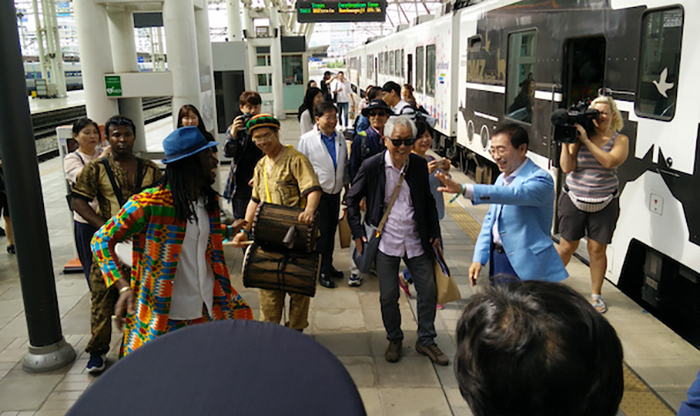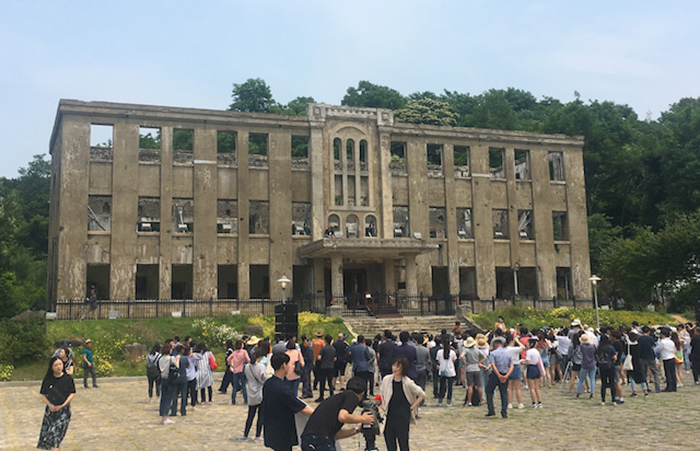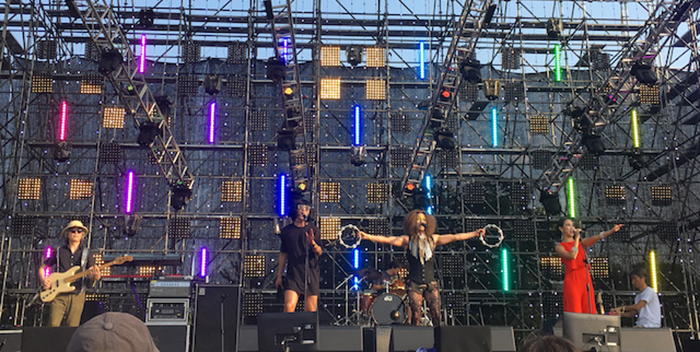View this article in another language
- 한국어
- English
- 日本語
- 中文
- العربية
- Español
- Français
- Deutsch
- Pусский
- Tiếng Việt
- Indonesian

A place of sad history is turned into a place of peace, along with music.
By Korea.net Honorary Reporter Vincenzo Acampora Carratura from Italy
Photos = Vincenzo Acampora Carratura and Chinghan Hsu
The first edition of the DMZ Peace Train Festival took place from June 21 to 24, with an opening event at the Platform Changdong 61 in Seoul, and continued for two days in symbolic and historical locations across Cheorwon-gun County. During the festival, 34 artists from seven different countries performed on stage, representing various musical genres, like rock, punk, folk and electronic.
The tensions between North Korea and the U.S. over the past year drew attention from people abroad, including non-Korean artists and musicians who performed during the Zandari festival that was held in Seoul in October 2017. Major labels expressed concern whether going to Korea and having their artists perform there during this festival was safe or not.
During the same period, many event promoters visited the DMZ, including Martin Elbourne, art director for big festivals like Glastonbury in the U.K., and Martin Goldschumidt, co-founder and managing director of the U.K. independent record label Cooking Vinyl. The visit to the Demilitarized Zone at the border between North Korea and South Korea inspired Elbourne to start this project that, far from being a commercial festival, would be dedicated to inspiring people to achieve peace and harmony through music.
The challenge was set. International artists organized a music festival in one of the most sensitive and fortified border regions in the world. The next step was to find sponsors for the festival. Fortunately, the Seoul mayor, Park Won-soon, Gangwon-do Province Governor Choi Moon-soon and Minister of Culture Do Jonghwan all agreed to get funding for the festival.

Seoul Mayor Park Won-soon (in blue jacket) dances together with Koulè Kan.
Many artists from all over the world showed their interest in and support for the festival, one of the first being Glen Matlock, a founding member of punk legend Sex Pistols. Quickly the lineup for the festival was complete, with Korean and non-Korean artists willing to join this unique festival.
The festival kicked off with international conferences at the Seoul Platform Changdong 61. Musicians, music industry executives and activists discussed how music could inspire people and strategies to build peace and unity through music.
We had the chance to join the festival on June 23 and 24. Only 140 people were able to board the Peace Train from Seoul Station and the journey on the train was already part of the festival. We enjoyed performances by the Korean band Galaxy Express and African Collective Koulè Can that kept us company during the train ride. Moreover there were also speeches by professors, organizers of the DMZ Festival and the Seoul mayor.
The itinerary included two representative locations in the DMZ: the Nodongdangsa (노동당사) and Woljeongri Station (월정리역). The first stop was the Nodongdangsa, the ruins of the former headquarters of the North Korean Workers' Party. A place with a dark past -- torture, detentions and questionings were the norm -- that was destroyed during the Korean War (1950-1953). Here we gathered together to admire a dance performance from Collective A and listened to the music of singer-songwriter Sunwoo Jung-A.
After the concert, we boarded the train again to Woljengri Station, whose buildings are s located just 100 m from North Korea. It is a historic location where there is still present the wreckage of a train bombed during the Korean War. This closed train station has become over the years a place for artists to perform and exhibit their artwork. Here we enjoyed the concerts of Bahngbek, Kang San-ae and Newton Faulkner.

The Nodongdangsa bears witness to many of the heartbroken stories in modern Korea.

Sssing Ssing is on stage at the festival.
Our trip continued to the main location of the festival, the Cheorwon Facilities Management Office, formerly known as the Iron Triangle Battlefield Hall. The Iron Triangle Battlefield was the name given to the area where heavy battle took place during the Korean War. It is also very close to the Goseogjeong, a natural landmark.
The program of the festival went on with performances alternating between two stages. There was a great atmosphere and many different people came together to enjoy themselves at the festival. People of different ages all came there to celebrate peace and to enjoy a great weekend of live music. The lineup included many great bands of different genres. We enjoyed the exhibition of Ssing Ssing, a folk-glam band that mixes traditional Korean singing with rock and electronic music. There was also punk legends Crying Nut, rock bands Jambinai, Kiha & Faces, and the Taiwanese indie rock band No Party for Cao Dong, among others.
The highlight of the festival was the exhibition of Glen Matlock, who joined Crying Nut and Cha Seung Woo on the closing song of the festival. They performed some classic Sex Pistols songs, like "God Save the Queen" and "Anarchy in the U.K." It was a strange feeling for me to see all these punk legends on stage and young people who were not even born when they were popular, dancing and singing together to the music. It's amazing how such music can bring different people together from all over the world to celebrate peace, at any latitude.
After their final songs, the organizers of the event joined the artists on stage and they all said goodbye to the audience and vowed to see each other again in the 2019 edition of the festival.
There is hope for the future and it would be great if in the coming years the festival were to be organized in North Korea, or have North Korean bands perform there, as well.
wisdom117@korea.kr
* This article is written by a Korea.net Honorary Reporter. Our group of Honorary Reporters are from all around the world, and they share with Korea.net their love and passion for all things Korean.